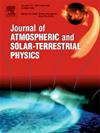Low-latitude sub-ionospheric VLF radio signal disturbances due to solar flares: Effects on the attenuation and phase velocities of the waveguide modes
IF 1.8
4区 地球科学
Q3 GEOCHEMISTRY & GEOPHYSICS
Journal of Atmospheric and Solar-Terrestrial Physics
Pub Date : 2025-01-18
DOI:10.1016/j.jastp.2025.106433
引用次数: 0
Abstract
Solar flares are sudden bursts of X-rays and UV rays emitted from coronal magnetic loops in active regions near sunspots on the sun’s surface. Soft X-rays below 1 nm penetrate the D-region ionosphere, causing excess ionization and altering its conductivity profile. This study examines solar flares (C-class and M-class) from the 25th solar cycle using two Very Low Frequency (VLF, 3–30 kHz) radio receivers in the low-latitude Indian region, located in Cooch Behar (CHB) and Kolkata (CUB). The work focuses on the Indian VLF transmitter VTX at a frequency of 18.2 kHz to study the effects of solar flares on the D-region ionosphere and VLF signal propagation characteristics in the earth-ionosphere waveguide. The solar zenith angle at the CUB station has a significant impact on the magnitude of VLF amplitude disruption caused by solar flares, showing a positive correlation (r = +0.82, r = +0.61) with flare power during low and high solar activity, respectively. In contrast, CHB exhibits both positive and negative amplitude perturbations, with a negative correlation (r = −0.83, r = −0.78) between flare power and VLF amplitude under similar conditions. The Long Wave Propagation Capability (LWPC) code has been used to explain the differences in the observed amplitude perturbations due to solar flares in both receivers. Solar flares weaker than C2.0 at CHB reduce attenuation and phase velocity of the propagating waveguide modes in the earth-ionosphere waveguide, causing positive amplitude perturbations, while stronger flares increase these parameters, resulting in negative perturbations. In contrast, solar flares of all classes cause an increase in phase velocities and a decrease in attenuation coefficients of the propagating waveguide modes along the VTX-CUB propagation path, resulting in positive VLF amplitude responses. This study highlights distinct responses of VLF signals to solar flares in different propagation paths, emphasizing the complex interactions between solar activity and earth-ionosphere waveguide properties.
求助全文
约1分钟内获得全文
求助全文
来源期刊

Journal of Atmospheric and Solar-Terrestrial Physics
地学-地球化学与地球物理
CiteScore
4.10
自引率
5.30%
发文量
95
审稿时长
6 months
期刊介绍:
The Journal of Atmospheric and Solar-Terrestrial Physics (JASTP) is an international journal concerned with the inter-disciplinary science of the Earth''s atmospheric and space environment, especially the highly varied and highly variable physical phenomena that occur in this natural laboratory and the processes that couple them.
The journal covers the physical processes operating in the troposphere, stratosphere, mesosphere, thermosphere, ionosphere, magnetosphere, the Sun, interplanetary medium, and heliosphere. Phenomena occurring in other "spheres", solar influences on climate, and supporting laboratory measurements are also considered. The journal deals especially with the coupling between the different regions.
Solar flares, coronal mass ejections, and other energetic events on the Sun create interesting and important perturbations in the near-Earth space environment. The physics of such "space weather" is central to the Journal of Atmospheric and Solar-Terrestrial Physics and the journal welcomes papers that lead in the direction of a predictive understanding of the coupled system. Regarding the upper atmosphere, the subjects of aeronomy, geomagnetism and geoelectricity, auroral phenomena, radio wave propagation, and plasma instabilities, are examples within the broad field of solar-terrestrial physics which emphasise the energy exchange between the solar wind, the magnetospheric and ionospheric plasmas, and the neutral gas. In the lower atmosphere, topics covered range from mesoscale to global scale dynamics, to atmospheric electricity, lightning and its effects, and to anthropogenic changes.
 求助内容:
求助内容: 应助结果提醒方式:
应助结果提醒方式:


